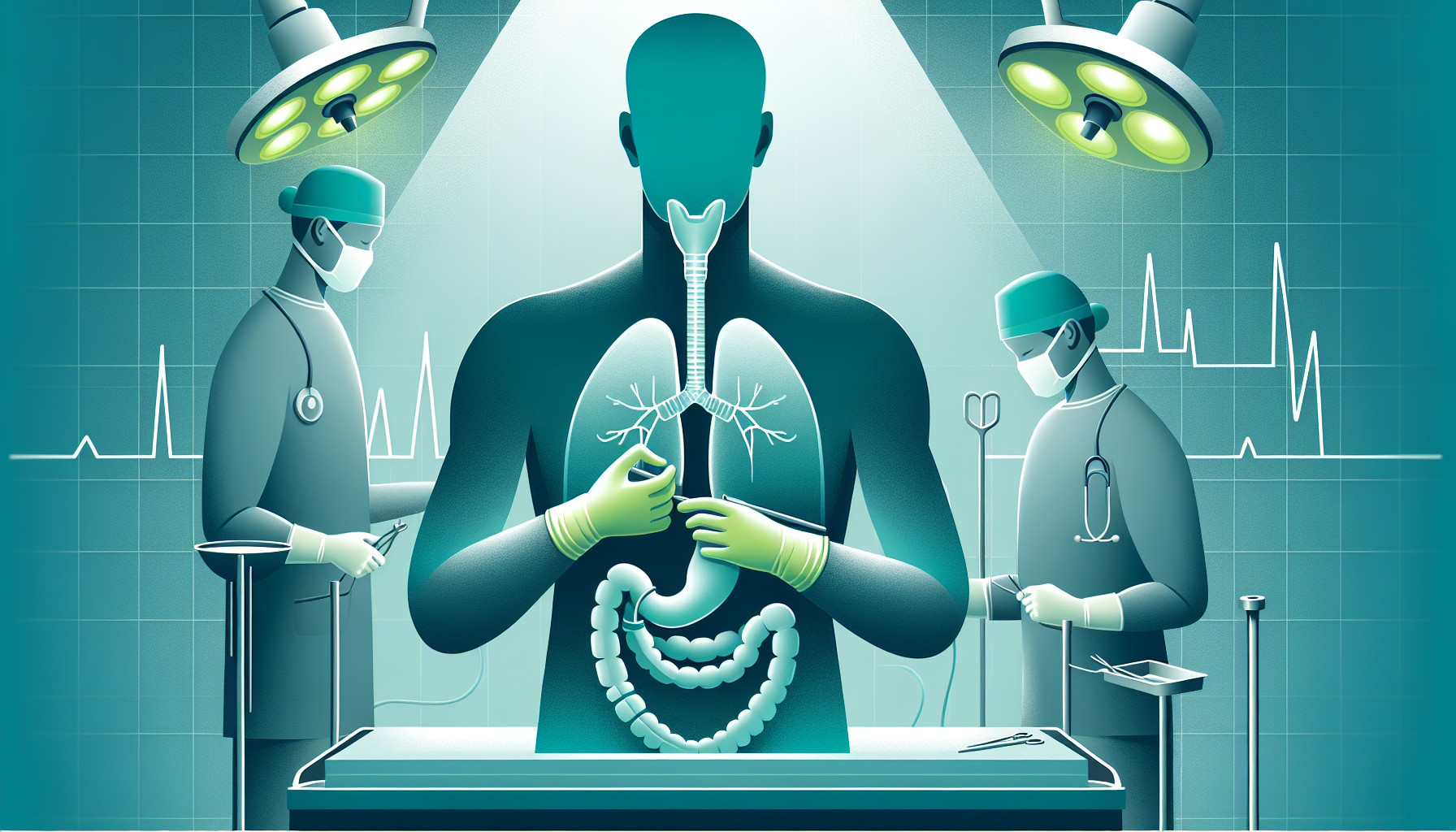Our Summary
This research paper discusses the use of a robot-assisted surgical procedure to remove parts of the esophagus, known as the Ivor Lewis procedure. The study was conducted at the University Hospital of Schleswig-Holstein, Campus Kiel, from November 2013 to November 2015. During this period, 56 patients underwent this type of surgery, with complete tumor removal achieved in 93.4% of cases.
The average hospital stay was 19 days, and the procedure had to be switched to traditional surgery in 34.1% of cases, mainly during the chest part of the surgery. Some complications included leakage, airway fistula, mesenteric ischemia, peritonitis and pulmonary complications. Four patients died due to complications such as pulmonary embolism, heart attack, and septic organ failure.
In conclusion, the researchers believe that robot-assisted, minimally invasive surgery to remove parts of the esophagus is a practical and beneficial approach for cancer surgery. However, they recommend that it should be implemented carefully, with continuous evaluation and collaboration with experienced surgical teams. As technology advances and surgeons gain more experience, this technique could become more widespread.
FAQs
- What is the Ivor Lewis procedure and how was it used in this research?
- What were the common complications experienced by patients who underwent this surgery?
- What recommendations did the researchers give regarding the implementation of robot-assisted esophagectomy?
Doctor’s Tip
A doctor might tell a patient undergoing an esophagectomy to follow their post-operative care instructions carefully, including taking prescribed medications, attending follow-up appointments, and avoiding certain foods or activities that could irritate the healing esophagus. It is also important for the patient to communicate any unusual symptoms or concerns to their healthcare team promptly.
Suitable For
Patients who are typically recommended for esophagectomy include those with esophageal cancer, particularly those with early-stage disease that has not spread beyond the esophagus. Other conditions that may warrant esophagectomy include severe gastroesophageal reflux disease (GERD) that has not responded to other treatments, Barrett’s esophagus with high-grade dysplasia, and benign esophageal conditions such as refractory strictures or diverticula.
Patients who are generally considered good candidates for esophagectomy are those who are in good overall health and have a strong likelihood of tolerating the surgery and recovering well. This may include patients who do not have significant comorbidities such as heart disease, lung disease, or other serious medical conditions. Additionally, patients who are able to tolerate the potential side effects and complications of esophagectomy, including changes in diet and potential long-term issues with swallowing and reflux, may be recommended for surgery.
It is important for patients to discuss the risks and benefits of esophagectomy with their healthcare team to determine if this procedure is the best option for their individual situation. Additionally, patients may benefit from seeking a second opinion or consulting with a multidisciplinary team of specialists to ensure that they are receiving the most appropriate and comprehensive care for their condition.
Timeline
Before the esophagectomy:
- Patient is diagnosed with esophageal cancer and undergoes various tests and consultations with medical professionals.
- Patient undergoes preoperative preparation including fasting, medication adjustments, and possibly chemotherapy or radiation therapy.
- Patient discusses the surgery with their surgeon and anesthesiologist, and signs consent forms.
- Patient is admitted to the hospital the day before surgery for final preparations.
After the esophagectomy:
- Patient undergoes the robot-assisted Ivor Lewis procedure to remove parts of the esophagus.
- Patient is monitored closely in the intensive care unit (ICU) immediately after surgery.
- Patient gradually transitions to a regular hospital room once stable.
- Patient begins postoperative care including pain management, physical therapy, and dietary adjustments.
- Patient is discharged from the hospital after an average stay of 19 days.
- Patient undergoes follow-up appointments and possibly additional treatments such as chemotherapy or radiation therapy.
- Patient may experience complications such as leakage, fistula, or pulmonary issues, which require further treatment and monitoring.
- Patient may experience long-term side effects such as difficulty swallowing, reflux, or changes in diet.
- Patient continues regular follow-up appointments to monitor for recurrence of cancer and overall health.
What to Ask Your Doctor
- What is the success rate of the Ivor Lewis procedure for esophagectomy?
- What is the average hospital stay for patients undergoing this surgery?
- What are the potential complications and risks associated with this procedure?
- How experienced is the surgical team in performing robot-assisted esophagectomies?
- Are there any specific criteria or conditions that make a patient a good candidate for this type of surgery?
- What is the recovery process like after undergoing an esophagectomy?
- How will my quality of life be impacted after this surgery?
- Are there any alternative treatment options available for my condition?
- What long-term follow-up care and monitoring will be needed after the surgery?
- How can I best prepare for the surgery and optimize my chances for a successful outcome?
Reference
Authors: Egberts JH, Aselmann H, Hauser C, Bernsmeier A, Carstens A, Hoecker J, Becker T. Journal: Zentralbl Chir. 2016 Apr;141(2):145-53. doi: 10.1055/s-0042-104196. Epub 2016 Apr 13. PMID: 27074211
